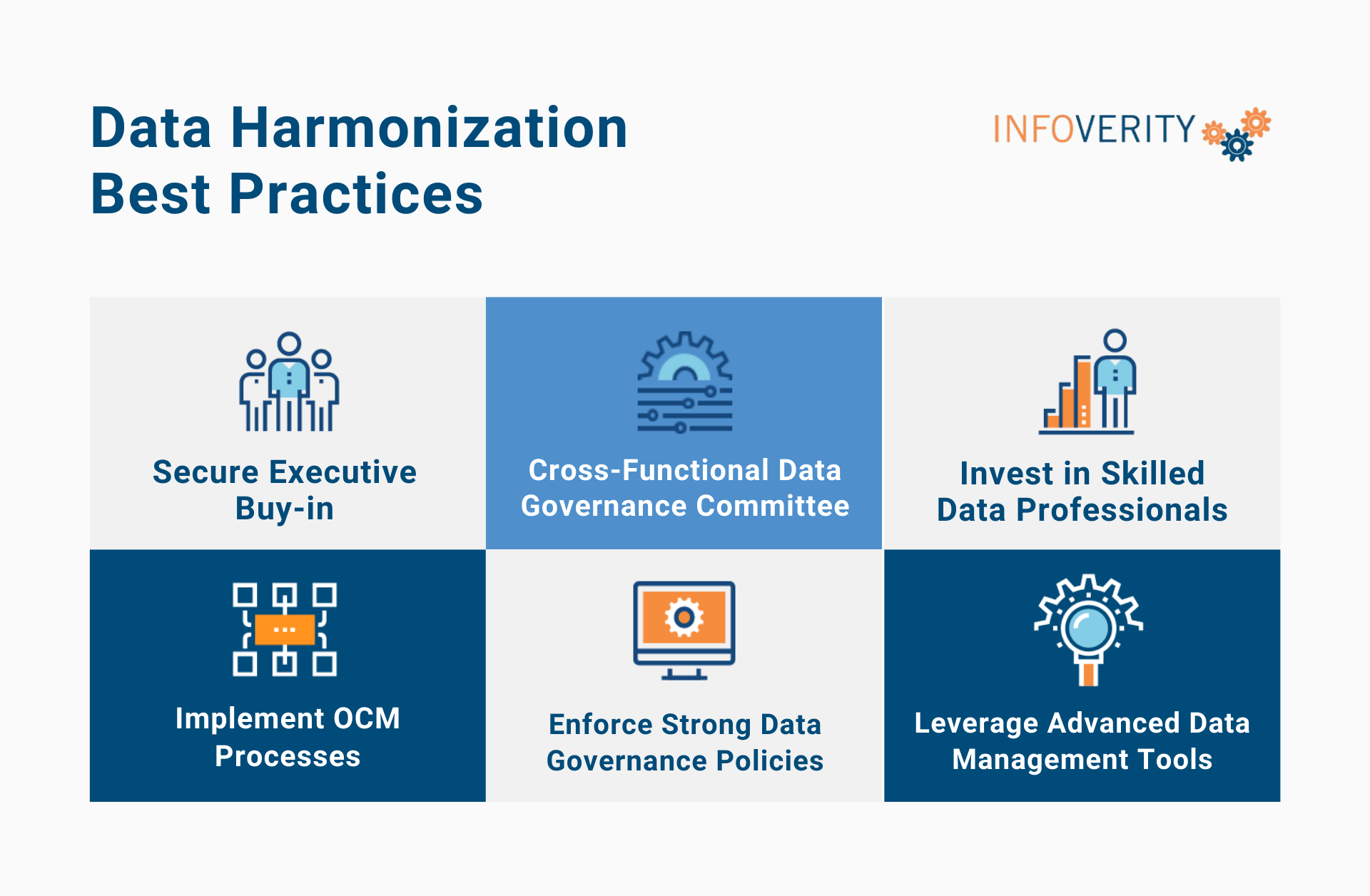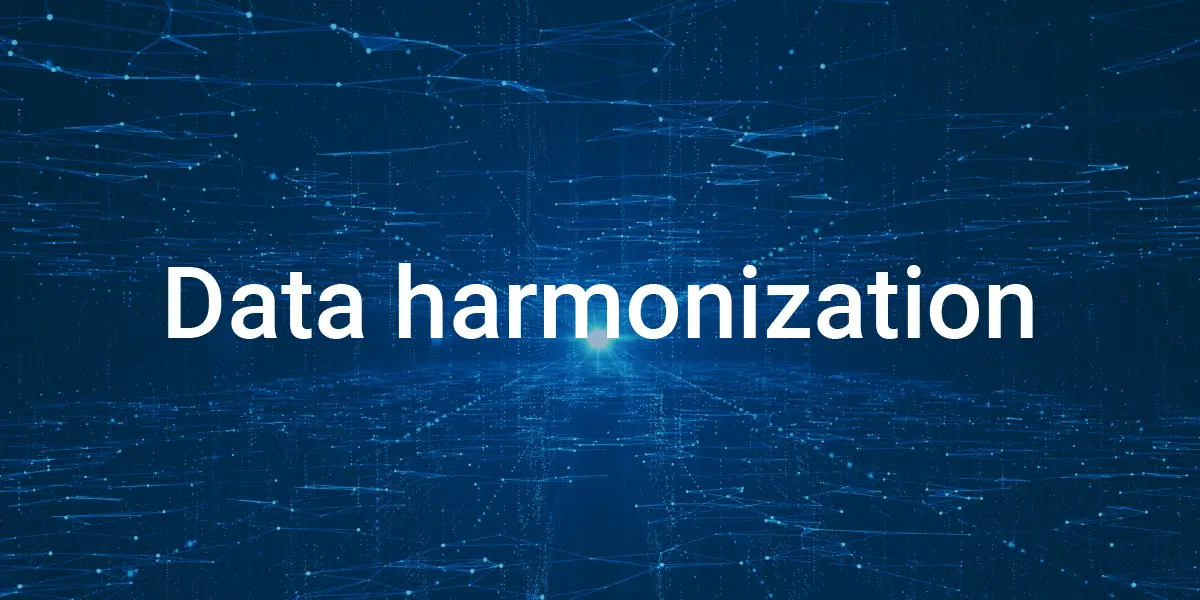Data harmonization is the process of aligning and integrating data from disparate sources and systems to achieve compatibility, consistency, and coherence.
When the pieces fit together into one big picture, everyone within the organization can see and understand the information clearly without misinterpretation of the format, standards, and structure. Consequently, this opens doors to consistent analysis and informed decision-making.
In this blog post, we’ll talk about its benefits, and its key implementation challenges and how to combat them.


Data Harmonization for Enterprises: Table of Contents
Benefits of Data Harmonization
Operational Efficiency and Enhanced Decision-Making
Out of 200 data professionals, 90% claimed that preparing data for analytics is challenging to some degree. At this point, data harmonization converts fragmented and inaccurate data into useful and accessible information.
Therefore, it can shorten the path to effective decision-making, saving tech teams up to 80% of their working time, which they usually dedicate to data collection and organization.
This newfound efficiency allows organizations to spend their time more effectively elsewhere. For instance, developing their business and boosting revenue, rather than hunting for the right data source.
Holistic View of Customers
Businesses interact with customers through various touchpoints, such as brick-and-mortar establishments, websites, social media, and email marketing. Some could even go up to 50.
Data harmonization connects customer data from these channels and creates a more comprehensive view of customer behavior. For this reason, it becomes easier to segment and target customers more effectively. This is the start of creating seamless customer experiences and creating products that are better suited to market needs.
Seamless Integration Following Acquisitions or Mergers
Nearly 40,000 M&A deals were completed in 2023. While this figure is lower than the previous years, megadeal activity is soaring. These companies have large datasets that need to work in symphony. In light of these challenges, harmonizing data allows them to achieve interoperability, system consolidation, and increased insight.
For example, when two financial institutes merge, there’s a high chance of having duplicate customer records. By harmonizing data, duplicate entries are consolidated into one, leading to accurate customer profiling. Furthermore, this consolidation leads to operational efficiencies (reduced IT costs) and strategic advantages (personalizing financial product offers).
Compliance with Regulatory Requirements
According to the Code of Practice for Statistics, harmonization is a recognized standard and a sound method when dealing with statistics, data, and metadata.
In a highly regulated industry like healthcare, accurate and consistent data improves reporting efficiency and mitigates risks, such as drug interactions and high-risk patients. Simultaneously, it secures patient data and complies with government regulations, such as HIPAA and GDPR.
Challenges of Implementing Data Harmonization
In light of its benefits, every organization should harmonize its data. But many companies put it off because it’s a complex process. They often run into roadblocks, such as:
- Difficulty getting executive buy-in and staff support for new data management practices. At this point, without support and proper training, employees will resist adopting new protocols.
- Lack of alignment between business definitions and processes. Because of this problem, modern companies ingest too much data, and they have to deal with diverse naming conventions, languages, regulations, etc. Without standardization, there’s too much noise to sift through before the unification of global data can take place.
- Getting applications and tools to speak the same language. This is especially complex and labor-intensive when bridging together legacy stems and software applications. For example, a supplier using an outdated CRM system might struggle to integrate it with a new data analytics platform, leading to more fragmented data.
Recommendation
These challenges aren’t impossible to overcome. With the right strategies, any organization–even one with sprawling data–can get their data working together in harmony.
Six Data Harmonization Best Practices
Data harmonization doesn’t follow a cookie-cutter approach. Furthermore, since every company works with different kinds of data, it must be customized according to their business mode and data strategy to truly measure performance.
However, there are six key best practices that companies can follow to achieve it. These strategies concentrate on three areas: processes, people, and technology.
1. Secure Executive Buy-in
Tech teams need to get leadership buy-in for data harmonization to take ground. The best way to have their ear is to outline how issues from lack of unified data impact the business as a whole. In addition, presenting metrics, case studies, and data ensures that the dialogue with leadership is objective, productive, and compelling.
2. Establish a Cross-Functional Data Governance Committee
Cross-functional data governance committees are responsible for ensuring alignment and accountability.
Committee members are often senior representatives from different departments like IT, sales, marketing, and operations. Together, they can establish and enforce a set of governance policies for the whole company. They can oversee data management practices, ensure consistent data definitions, and provide assistance when needed.
3. Invest in Skilled Data Professionals
To achieve data harmonization, companies need to work with data scientists and engineers to manage complex integrations and data transformations.
This means investing in training existing employees or hiring skilled data professionals. On the other hand, outsourcing is also a scalable and economical option, as it helps companies access a wide range of expertise necessary for data harmonization.
4. Implement Organizational Change Management Processes
Change within an organization is only possible when its members change. Furthermore, companies need to ensure that employees receive the support they need for every data transformation initiative they take on.
One way to do it is by implementing structured change management models like ADKAR (Awareness, Desire, Knowledge, Ability, Reinforcement). Research shows that this strategy can help enable 47% of organizations that integrate it to meet their objectives.
5. Enforce Strong Data Governance Policies
Data governance policies are like the sheet music an orchestra needs to create a perfect harmony. For organizations, these serve as absolute guidelines for gathering reliable and useful data. Specifically, these also outline data stewardship roles that ensure data integrity and quality.
6. Leverage Advanced Data Management Tools
Harmonizing data requires technological assistance. In essence, below are a few tools companies should have at their disposal–but this is by no means a comprehensive list:
- Master Data Management tools create a single source of truth for organizational data.
- Integration accelerators are pre-assembled solutions that provide the relevant components needed to connect disparate systems and apps.
- Data warehousing and analytics platforms synchronize, manage, and analyze data in one place.
Altogether, these technologies enable enterprise-wide data management and utilization.

In Perfect Data Harmony
Data harmonization puts data to good use, allowing organizations to gather accurate information, make informed decisions, and produce tangible results
The modern data landscape presents many challenges, but it’s not an impossible feat to get company data working harmoniously. Combining organizational commitment and automated processes can produce great results.
Optimize your data for peak performance with Infoverity. We can help you get over the hurdles of modern data management. Contact us today.
FAQ – Data Harmonization
What is data harmonization?
Data harmonization is the process of aligning and integrating data from disparate sources and systems to achieve compatibility, consistency, and coherence. This opens doors to consistent analysis and informed decision-making.
What are the benefits of data harmonization?
Data harmonization streamlines operations, improves decision-making, and enhances customer insights by unifying fragmented data. It simplifies compliance, supports seamless integration during mergers, and saves tech teams valuable time. By consolidating data across multiple touchpoints, businesses can create personalized experiences, boost efficiency, and ensure regulatory adherence.
What are the best practices in data harmonization?
Effective data harmonization requires executive buy-in, strong governance, skilled professionals, and the right technology. Organizations should establish cross-functional governance committees, invest in data experts, and implement structured change management processes. Enforcing clear policies and leveraging advanced tools like MDM and analytics platforms ensures data integrity, streamlines integration, and maximizes business value.
What are the challenges of implementing data harmonization?
Implementing data harmonization can be challenging due to resistance from employees, misalignment of business definitions, and integration issues with legacy systems. Without executive buy-in and proper training, adoption can be slow. Standardizing diverse data sources and ensuring seamless communication between tools require effort but are essential for success. With the right strategies, any organization can overcome these hurdles and unify its data effectively.



